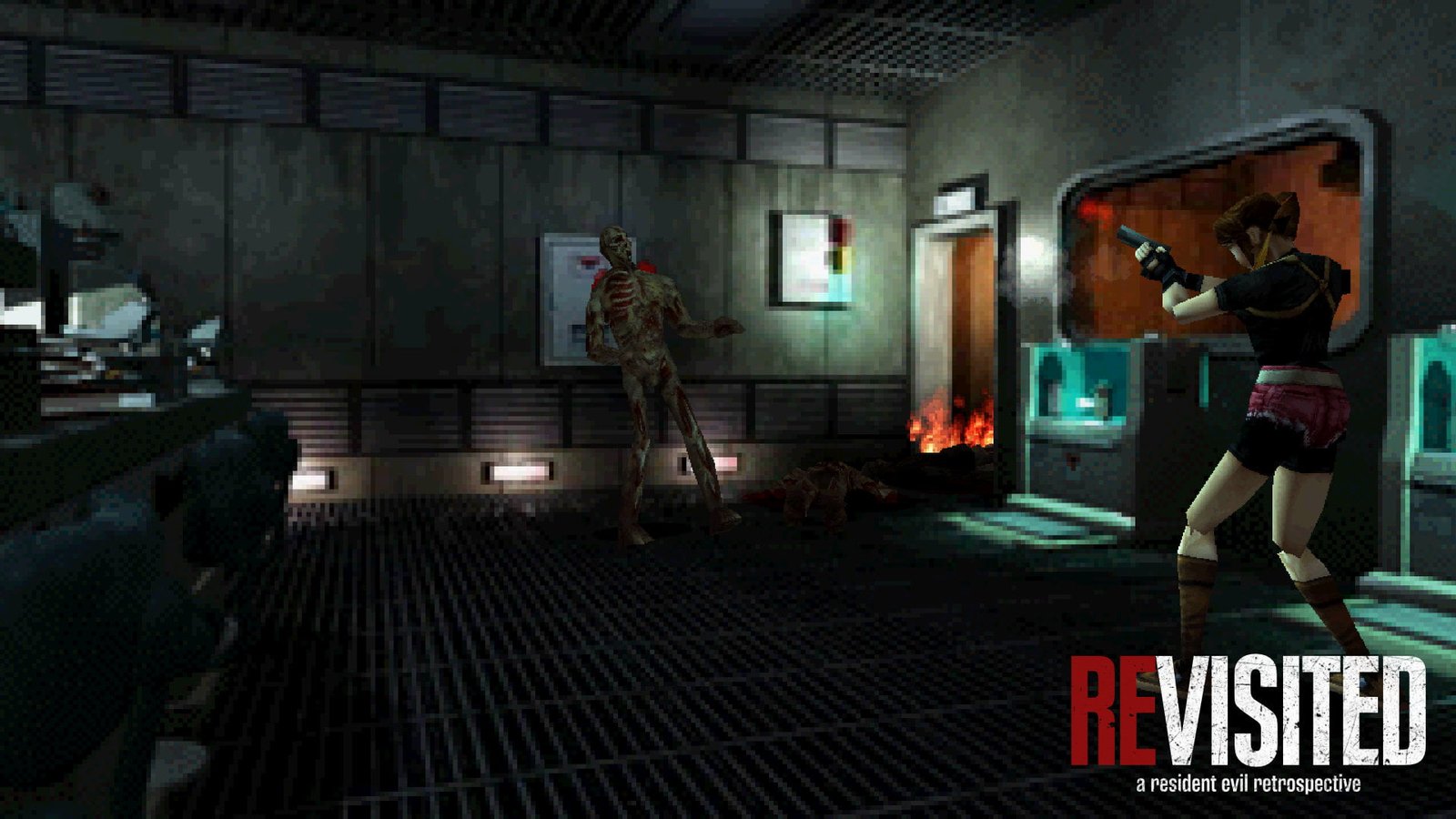The first time I came across Resident Evil 2 was during a Thanksgiving with my extended family. My cousins had rented a PlayStation for the long holiday weekend and brought it with them to the all-day festivities at my aunt and uncle’s house. Eight boys crowded around the den TV while the oldest of us played the game. Our fun was short-lived, though. A parent popped in, saw the pixelated carnage, and shut us down. We may have gone on to play something else, but honestly, all I remember after that was watching Austin Powers until the food was ready… I’d have been 14? I wouldn’t play RE2 myself for another five or six years.
I was in college when I finally played the PlayStation classic. By then I’d played the heck out of Resident Evil Remake and Resident Evil Zero and decided to go back and try the PSX originals. But with that having been something like 18 years ago (goddamn!), I only remembered the broad strokes of what happened in those games. And similar to what had happened with the original Resident Evil and its remake, the remakes of Resident Evil 2 and Resident Evil 3 further muddied my memory of the originals.
But here I am! It’s 18 years later (…and it’s not getting any easier confronting that), and I’m diving in and returning to the franchise’s roots.
Welcome to REvisited: A Resident Evil Retrospective, an Exposition Break series that explores the highs and lows of the Resident Evil franchise as we go back and replay the mainline games, their remakes, and their spinoffs. If you haven’t already, we encourage you to check out the series introduction to learn more about this project.
Building a franchise
While I’m sure Shinji Mikami and the rest of the people behind 1996’s Resident Evil had high hopes for their survival horror experiment, I can’t imagine a single person on the team could have predicted the game’s reception and success. They were fortunate, then, that their original game had managed to set a grand stage that would allow sequels to easily leave the confines of the Spencer Mansion and extend horrors beyond simple zombies (and crows, snakes, spiders, sharks, dogs…). Sure, you can make a sequel to anything if you try hard enough, but Resident Evil managed to walk a difficult line, managing to be a self-contained satisfying story while also creating a world outside of its relatively modest setting. A sequel was far from guaranteed and it’s a better game for not assuming one would happen.
But the game WAS a success and in 2022 we have nine mainline numbered entries (don’t forget about Zero), three remakes (with a fourth on the way), and plenty of cross-media spinoffs. But even with the success of the first game, the path forward for the franchise wasn’t clear or easy. Resident Evil 2 had a troubled creation and an entire version was scrapped mid-development, forcing the team to start over. Game director Hideki Kamiya was almost forced out of his role by his staff, only managing to remain in charge because of Shinji Mikami’s confidence and support. Outside help was brought in to help re-write the game, salvaging a few pieces of the canceled version while removing what didn’t work and introducing a cohesiveness that had been previously missing—not just within itself, but with the first game as well. Development was brought back on track, and in 1998 players got to step into the shoes of Leon S. Kennedy and Claire Redfield for the first time.
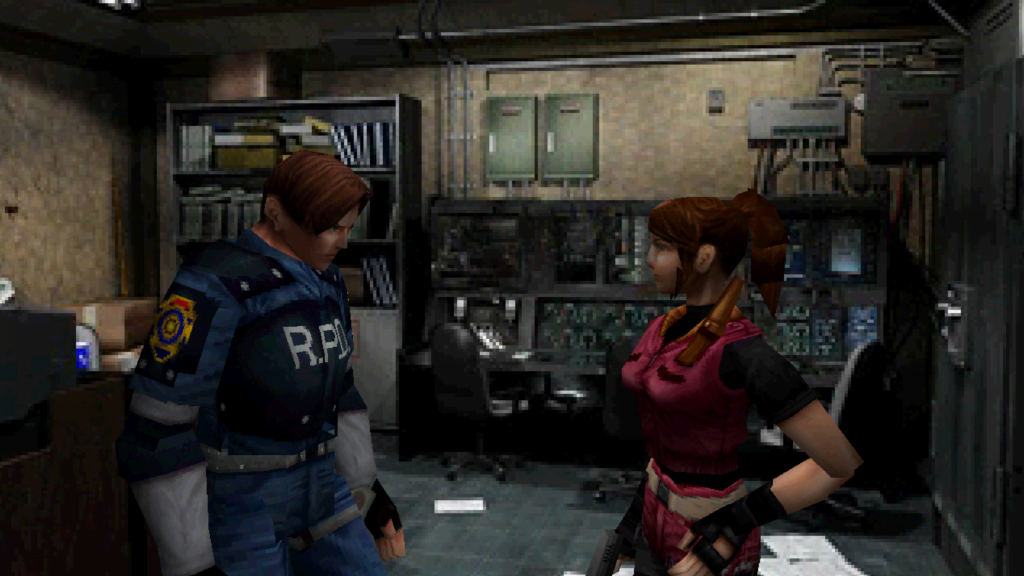
A humble confession
When I was considering this project, the thought of replaying Resident Evil 2 and Resident Evil 3 gave me pause. Looking back at my experiences with the games, my feelings around them ranged from apathy for 2 to outright annoyance with 3. My actual memories of the games themselves had been lost to time, but those feelings remained. Ironically, my apathy and annoyance with the games were a big part of my decision to move forward with REvisisted. I had opinions of the games with no memories to support them, so I decided it was time to give them another chance. Then, at the very least, I could have confidence in my judgments.
Sooooooo… here’s where I confess that I was wrong about Resident Evil 2. It’s a terrific game that is better than the first in almost every way, and my apathy towards it until now goes to prove my growth as a person and a (ugh) gamer. There’s a lot to unpack as to why it’s such a great game, but it’s hard to talk about Resident Evil 2 without first going over what happens in Resident Evil 2. So let’s start there.
The Raccoon City Incident
[Note: Depending on which character you pick at the start of Resident Evil 2, the story can play out differently. This recap is based on Leon’s A story, Claire’s B story, and a little bit of interpretation of my own. Some key plot points from Claire’s A story might be missing.]
Two months after Jill Valentine, Chris Redfield, Barry Burton, Rebecca Chambers, and Brad “left you for dead” Vickers survived the events of the first game, Chris’s younger sister, Claire, is on her way into Raccoon City hoping to find Chris, who’s gone dark. On the outskirts of town, she’s attacked by a zombie and is rescued by rookie R.P.D. cop, Leon S. Kennedy. It’s Leon’s first day on the force, and what a first day it’s going to be.
Claire joins Leon and they continue into Raccoon City together only to find that the whole city has been overrun with zombies. They don’t know it yet, but the virus the S.T.A.R.S. teams encountered in the Arklay Mountains has spread to the city and almost everybody has been infected. An accident separates the two survivors and they’re forced to split up and separately find their way into the Raccoon Police Station.
Inside, Claire and Leon start to unravel the truth about the outbreak and Umbrella’s involvement. The surviving S.T.A.R.S. members had been trying to reveal the truth about Umbrella in the months after the mansion incident, but had been left with no evidence after the mansion exploded. On top of that, R.P.D.’s chief, Brian Irons, was on the take from Umbrella and silencing Jill, Chris, Barry, Rebecca, and Brad at every turn (he also has a murder dungeon complete with torches and a medieval door). Claire also learns that Chris has left for Europe with Barry, hoping to take the fight to Umbrella at their headquarters.
Meanwhile, two other survivors are roaming the halls of the police station. One is a little girl named Sherry Birken whose parents had told her to run to the safety of the R.P.D., not knowing how bad things had gotten within. The other is a woman named Ada Wong, who’s in Raccoon City looking for her husband, a missing Umbrella employee. Claire eventually crosses paths with Sherry and takes the little girl under her wing, keeping her safe as best she can. Leon meets Ada in the station’s parking garage and she reluctantly agrees to team up with the rookie cop as they continue into the sewers beneath the building.
Two new, serious threats emerge as Claire, Sherry, Leon, and Ada explore. Umbrella has airdropped a nigh-unstoppable, trench coat-clad tyrant onto the roof who actively hunts the survivors throughout the station’s halls, while a horrifically mutated scientist skulks in the sewers beneath the station.

After narrowly escaping multiple encounters with the two monsters, the teams eventually find their ways into a secret Umbrella laboratory hidden beneath Raccoon City. Sherry stays in a safe spot as Claire looks for a way to escape. The laboratory is empty except for one paranoid scientist, Sherry’s mother, Annette Birkin. It’s revealed that the mutated scientist who’s been giving the survivors so much trouble is actually William Birkin, Sherry’s father. He’s been infected with a new virus strain of his own creation called the Golgotha Virus (or G-Virus) that causes extreme mutations far beyond those caused by the T-Virus. Umbrella had found out that he’d gone rogue and sent agents to retrieve the virus from him. During a tense standoff, an agent opened fire and shot Birkin. Hungry for revenge, Birkin used his remaining strength to infect himself with the G-Virus, mutating into a monster and killing the agents.
Few samples of the virus remain. Claire learns that one is hidden within the locket Sherry is wearing. It turns out that the tyrant hunting them had been programmed by Umbrella to recover the sample from Sherry at any cost. In a confrontation with the tyrant, Claire throws the locket into a molten pit and the monster falls in after it. She and Sherry hurry to an underground train to make their escape but are confronted one last time by the tyrant. A mysterious woman throws Claire a rocket launcher and she finally dispatches the monster once and for all.
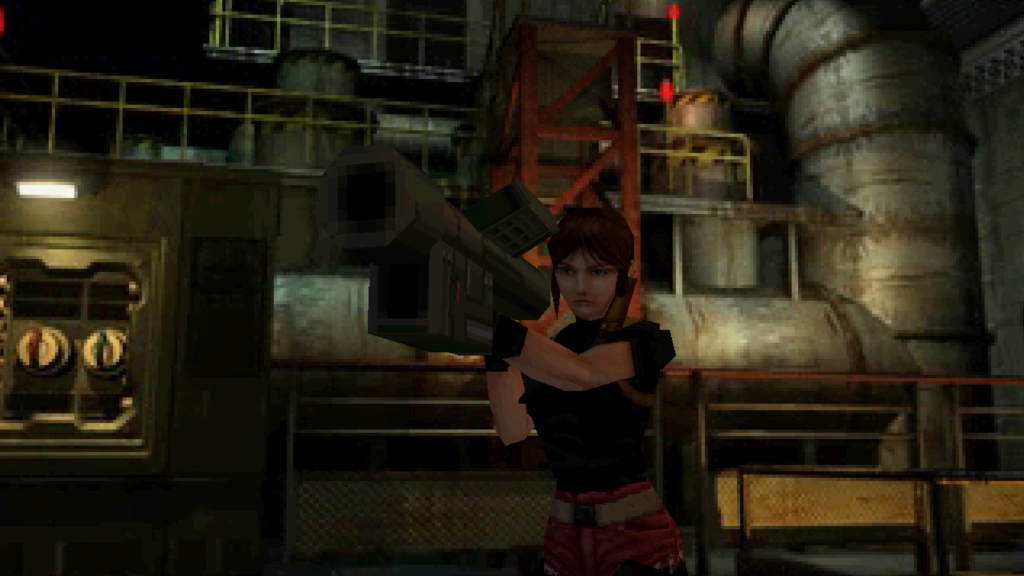
Leon finds another sample of the virus within the lab but is quickly betrayed by Ada, who pulls a gun on Leon and demands the sample. She’s a spy for another, unknown company and had been after Umbrella’s research all along. It clearly pains her to turn on Leon, but before the encounter can go one way or another, Ada is shot by Annette Birkin and falls over the railing. Leon tries to save her, but can’t. In his grief, he throws the sample over the edge into the darkness below before making his escape to the train.
When he gets there, Claire and Sherry already have the train ready to depart and he manages to get onboard just as it leaves the station. The lab’s self-destruct triggers behind them as they make their escape, finally killing the monster that was William Birkin and destroying Umbrella’s lab and presumably any evidence within.
How do you solve a problem like Ada?
There is so much more to Resident Evil 2‘s story compared to the first game that it’s hard to know where to start. It takes everything set up by RE1 and expands on it, but it’s the subtle touches that really help to further build the universe. Take Ada, for example. People that played the first game might remember finding a heartfelt letter from a dying scientist addressed to a woman with the same name. When I met Ada in RE2 I thought to myself, “Hey, that’s a funny coincidence. Surely this isn’t THAT Ada.” After spending hours becoming desensitized to everything going on in the mansion, the letter exists to re-ground the player and remind them of the human cost of the outbreak; Shinji Mikami and his team weren’t trying to set up a cool reveal in a sequel that might never exist. The names don’t feel important on that playthrough because, at the time, they weren’t. But that is also why the reveal works so well in 2.
On the surface, Ada is a walking cliché. A femme fatale. As such, she’s hard to take seriously as a character. From the moment you meet her, you know that she’s up to no good. But the writers did an ingenious thing by connecting her with the letter from the first game. For players that make the connection, it suddenly gives Ada a life and history beyond the moments where she is onscreen. With that, she becomes more than the cliché and we might even begin to empathize with her. Maybe even trust her. She says she’s looking for her husband, and if you remember the letter, her story actually checks out.
“But why does that matter?” you might ask. “My trust in her has no bearing on the story.” And you’d be right. It’s Leon’s trust that matters, and he chooses to believe her. The connection to the first game exists only for the player. Without that knowledge, Leon is simply naïve. However, giving the player a reason to trust Ada makes it easier for us to empathize with Leon’s choices, even if it’s for different reasons.

Thank you, Claire! But our Chris is in another castle!
As we continue this journey through the franchise, one trend will quickly become apparent (it’s actually two, but more on that later): people spend a lot of time looking for Chris. It starts in the first game in Jill’s story and continues in Resident Evil 2 in Claire’s. Chris can’t be bothered to leave a forwarding address and his whereabouts are often unknown.
Claire’s entire reason for being in Raccoon City at the start of this game is that she is looking for her brother. I don’t recall at this point if it is explicitly stated that he was ignoring her because he was trying to protect her (seems likely), but ummm… mission failed, buddy. Your mysterious departure wound up putting your sister in the most dangerous place on the planet, and I can’t help but feel this was avoidable. Sure, hindsight is 20/20, but even without the zombie outbreak Raccoon City seems like the last place you’d want your sister to be given the hornet’s nest you were kicking. Just talk to your sister. It’s not like Umbrella wouldn’t have already been tracking her. Actually, now that I’m reflecting on this a little bit more… Chris just has some major problems with communication (Resident Evil Village, I’m looking at you.)
Excuse me, I have some family members to call…
I think my favorite part of RE2‘s “Chris is missing” plot is how quickly it’s solved and dismissed in the game thanks to a well-timed fax coming through to the S.T.A.R.S. fax machine. Oh, he went to Europe… cool… I guess I just need to get out of this hellhole now. Try sending a postcard next time, asshole (he won’t).
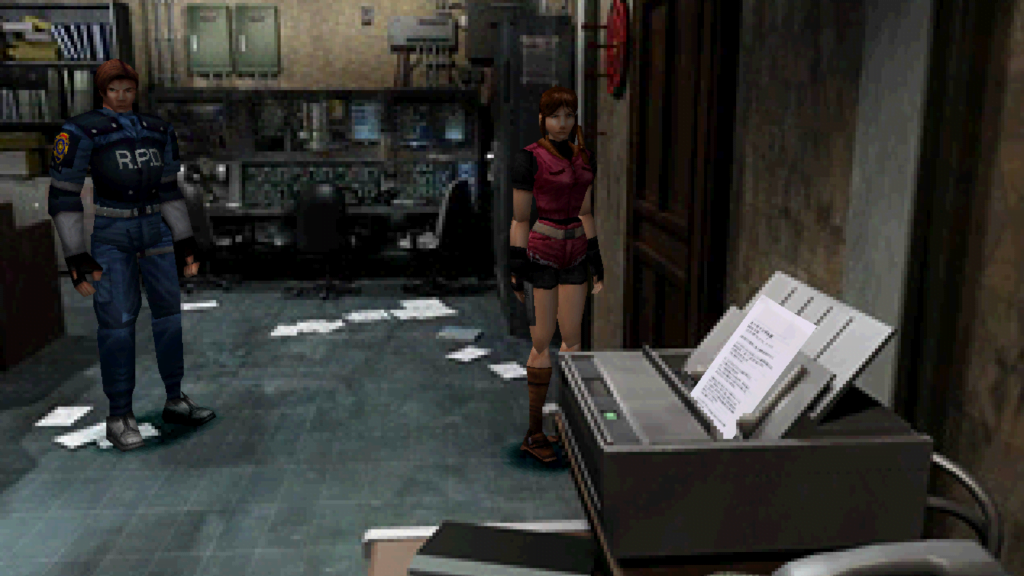
Anyway, just before the credits role, Claire tells Leon things aren’t over and says that they still need to find Chris—setting up a sequel (but not Resident Evil 3!).
I’ll take my chances with the zombies; thank you very much.
I didn’t mention it in the story recap, but at one point a helicopter hovers above the police station and attempts to rescue a survivor from the rooftop as zombies close in. In the chaos, a gun goes off, killing the pilot, and the helicopter crashes into the building, erupting into a fireball as Claire/Leon watches. This is the second trend I mentioned earlier. If you’re in a helicopter and you’re NOT one of the main characters, you’re going down. At least, that is the way I remember it.
With two games behind me, there’ve been three helicopters—two of which have crashed. The first crash was Bravo team’s helicopter in the first game. The second was the crash above. I think it’s time to start tracking this.
| Games Played | Helicopters Crashed | Helicopters Survived |
|---|---|---|
| 2 | 2 | 1 |
This time, evil has a face… well, three four faces
While the first game relied on a largely faceless, detached threat—only truly revealing Wesker’s treachery in the last hour of the game—Resident Evil 2 gives us a relative cornucopia of antagonists to worry about. First, we’ve got the corrupt police chief, Brian Irons. Even when compared to the zombies and monsters in the game, Irons, a regular-ass human, feels the most threatening. In fact, it’s his regular-ass humanness that makes him so damn threatening. It takes no stretching of the imagination to picture a man with his power taking bribes at the expense of the people he’s supposed to be protecting. It’s even believable when things take an even more unsettling turn with his murder lust and taxidermy. He’s a man teetering on the edge of becoming a serial killer. There’s even a document you find in the game (and I don’t think this exists in the remake) that goes as far as saying he raped two women in college. It’s dark, and the remake is better for removing it, but it sure does help make his transition into a corrupt murder-dungeon-having asshole all the more believable. Irons is eventually killed by the monster that was William Birkin and it sucks that he doesn’t culminate in a boss fight of some kind. Heck, it would have also been great if he’d been bitten and just become a zombie.
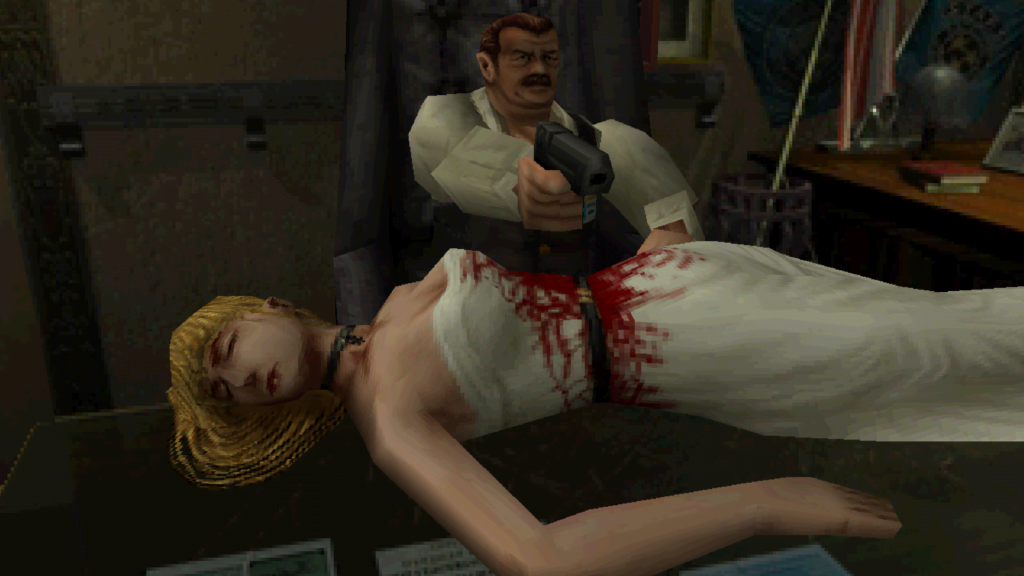
Next up are Sherry’s parents, William and Annette Birkin. Originally, in my notes, I’d just written down William’s name, but Annette deserves to make the list even if it’s just for some really bad parenting. They put a sample of a world-ending virus in her locket, for God’s sake. Of course, she is awful for other reasons, but I actually find it a bit hard to care about the corporate posturing taking place in the shadows of Resident Evil lore. Beyond the horrible parenting, they’re just two bad scientists doing bad things in a world full of bad scientists doing bad things.
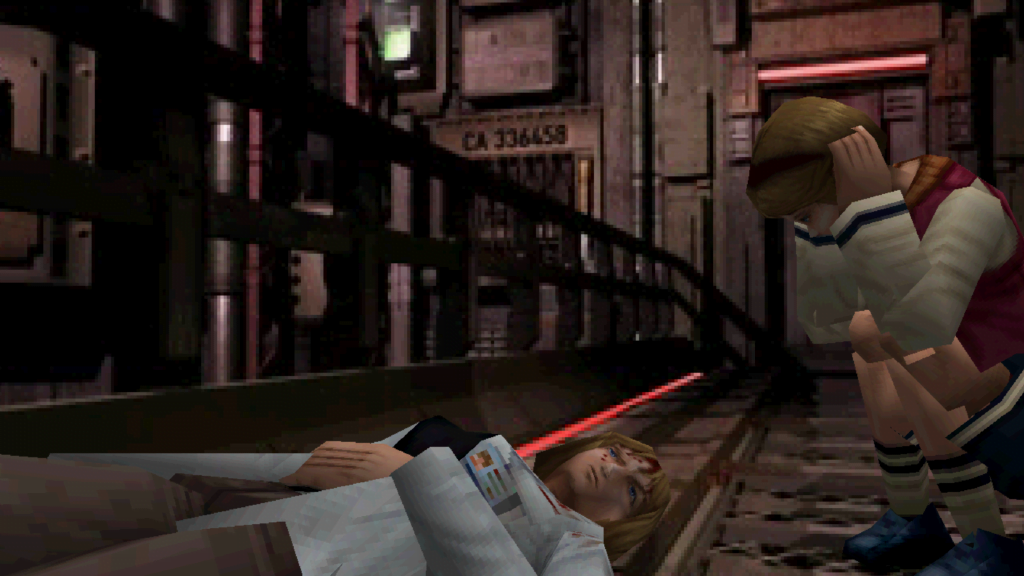
Last is Mr. X. When Capcom’s remake of Resident Evil 2 came out in 2019 people couldn’t stop talking about the game’s trenchcoat-clad tyrant that roamed the station’s halls in real time, threatening to interrupt you at any moment. I didn’t remember Mr. X from the original and assumed that it was just another thing I’d forgotten, but imagine my surprise when I finished Leon’s story this time around and never once saw the iconic hulking antagonist. A quick google search revealed that Mr. X only shows up in the game’s B stories—the altered campaigns that are unlocked after completing the game. I hadn’t actually intended to play a B story as part of this project, at least not right away, but I couldn’t very well move on to RE3 without first experiencing the original Mr. X for myself. And my possibly controversial opinion is that despite being relegated to the B stories (he should have been in the A’s) he is better implemented here than in the remake. While the remake’s version has the potential for some cool emergent moments, Mr. X is more often than not just a nuisance. In the original, his scripted encounters end up being more interesting and better paced.

And with the big baddies out of the way, it’s time for our…
Enemy round-up!
| Humanoid | Animals/Bugs | Mutants |
|---|---|---|
| Zombies | Crows Zombie Dogs Giant Spiders Large Roaches Giant Alligator Giant Moths Larva Sharks Wasps | Tyrants (Mr. X is a tyrant) G-Types (Includes W. Birkin) Lickers Ivy |
Before I started making a list, it felt like Resident Evil 2 line-up was more limited than the first game, but looking at it now it’s clear that I was wrong. And, oh man, I almost totally forgot about the giant alligator! It’s actually an amazing setpiece for its time, and was probably my favorite moment in the game.
I was very happy that hunters and chimera didn’t return and think that the lickers are a pretty amazing addition. Lickers are neat because they actually have behaviors that make you play differently. They’re blind, so walking actually allows you to sneak up on them and sometimes sneak past them.
Meanwhile in another part of the police station…
Let’s circle back on the game’s B stories. After finishing Leon or Claire’s story, you’re given the chance to start a new playthrough as the other character in a story that is supposed to take place alongside your original playthrough. I love the idea on paper, but the devs clearly had trouble implementing it in a truly meaningful way. You end up repeating many of the same puzzles, even though they should have already been completed in the A story. It’s almost like Mr. X is secretly running around resetting puzzles and locking doors after Leon passes through an area and is mostly just annoyed when Claire interrupts him.
Excuse me, I have some fanfiction to go write…
That isn’t to say that there isn’t anything meaningful or interesting in the B stories. There are two particular interactions between the two scenarios that are actually pretty cool.
The first is near the station’s parking garage. You come across two items, a satchel that increases your inventory space and a submachine gun. Trying to take both items brings up a prompt letting you know that you should probably leave something for the other character. It turns out that whatever you leave behind at this moment will be available in the B story. Taking both leaves nothing for the other character.
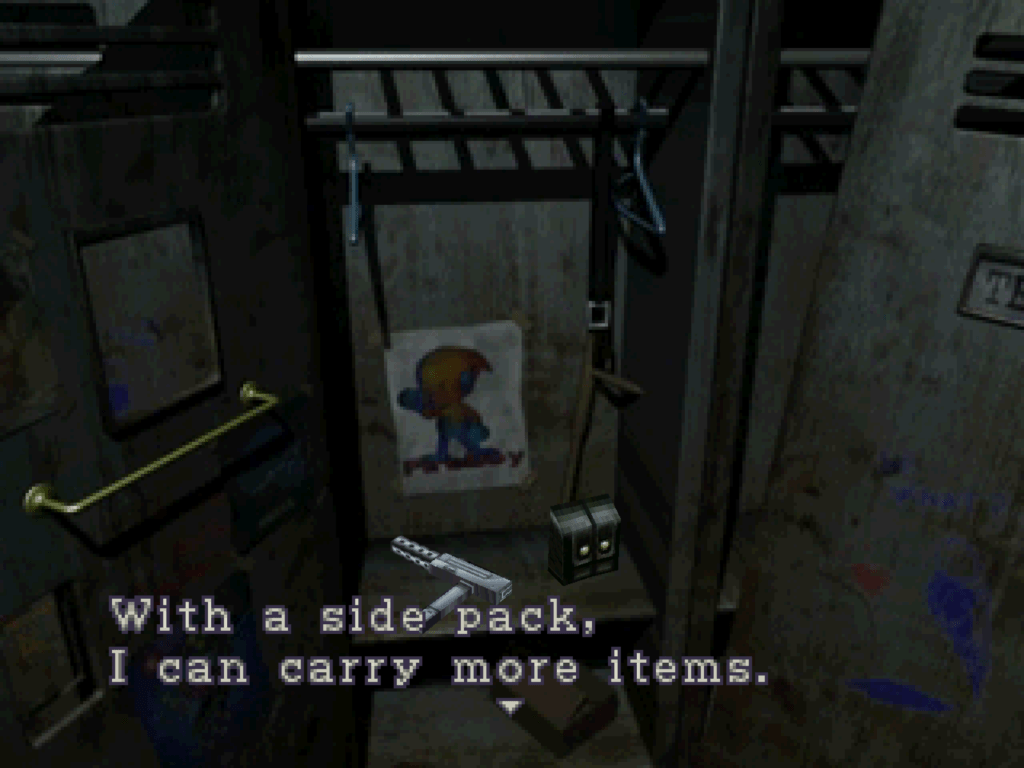
The second is in the lab and is a little more complex. In your A story, you get a chance to register your biometrics in the lab’s security database and that allows you to disengage one of two biometric locks on a particular door. In my playthrough, I actually assumed I’d messed something up and had needed to somehow get Ada to disable the second lock. But it turned out to actually be a bit more clever than that. It is actually the B character that gets to undo the second lock, gaining access to an extra weapon or ammo.
They’re both very cool pieces of continuity between the A and B stories, but they also unfortunately make the other shortcomings between them all the more glaring. You can’t help but ask, “Why do these things carry over, but an unlocked door doesn’t?” The answer is of course “gameplay,” but that doesn’t make it any less awkward.
Evolving the formula
At a superficial level, Resident Evil 2‘s gameplay is the same as its predecessor. It still has tank controls, pre-rendered backgrounds, limited inventory, puzzles, and ink ribbons, but there are a lot of changes, some big and some small, that end up making it a pretty different game from the first.
I find the way the game starts fascinating. The moment you are given control, you’re surrounded by more zombies than you ever see on a single screen in the original, and you barely have any ammunition. Running is really your only option, but the following screen transitions set up a difficult path that requires you to think quickly and be fairly adept with the tank controls as you weave between threats. It seems, at first, that Resident Evil 2 is going to be even more demanding with its ammo conservation than the first game and wants you to master dodging zombies as early as possible. The path to the police station feels like a practice test that you are meant to repeat until you’re confident enough to move on to the rest of the game. But then things shift. I might be exaggerating, but it felt like I fired more shots in the first hour of Resident Evil 2 than I did in the entirety of the first game. The station’s narrow corridors mixed with higher zombie counts and more bullets meant I was cutting my way through the encounters instead of avoiding them. Sure, there were moments when I’d zigzag past a zombie, but that was usually after taking out two or three of his friends.
Another thing that sets 2 apart from 1 is its use of animation. Now you can see how your character is doing based on changes to their idle and walking animations. Not only does this mean you spend less time in menus and have a more intuitive read on the situation, it also greatly improves immersion. My absolute favorite change in this area is how your character’s backstepping animation is different if you’re close to a zombie. It really adds to the tension of those close-up moments.

A worthy successor
As I said before, I came to this game with low expectations and was more than pleasantly surprised by what I got. On one hand, I’m a bit ashamed of myself for not realizing how great it is sooner, but also happy that I’ve grown to appreciate it now. While I’ll always love the mansion from the first game, RE2 is an improvement in almost every other way and I’m so happy I gave it another shot. I’m curious what else will surprise me as I continue this project. Maybe I’m wrong about Resident Evil 3. Maybe it isn’t one of the worst Resident Evil games. We’ll find out! See you next time!

